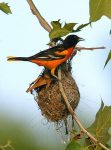Nesting is all bird clan habit when the laying egg time is come. It is a place that they make to safe their egg while waiting cracked moment. Nesting is also their effort prove that bird is actually genius survivor. Who’s ever thing that by their small body they still be able to build nest.
Talking about nest, there is so much method by bird to build a nest. Not every bird building their nest hanging in the tree. There is also build it to underground, inside the tree, and also make it on building. Sooty-headed Bulbul will use their beak to sculpting tree trunks so they can make it home. With a sharp and strong beak, he drilled and carved the tree into a nest. They also drill the bark to look for insects and larvae that live there. In addition, tree hole is made, also serve to store food in the form of grain. Kingfisher builds nest in collaboration with their partners. First, they make a tunnel to enter a small oval-shaped nest. Then, push the soil that has been dug out through the tunnel. Kingfisher build nests in collaboration with their partners. First, they make a tunnel to enter a small oval-shaped nest. Then, push the soil that has been dug out through the tunnel.
It may different for Baltimore Oriole to build nest. As mentioned before that every bird has different style to build their nest do relate to Baltimore Oriole. The bird that can’t be pet this has different style to build their nest. Here is some fact about Baltimore Oriole nesting habit.
- The female will choose the place
Female Baltimore Oriole will find the right location to build a nest. She could not find a distant place other than in the territorial area of the Baltimore Oriole male. Because their nest is built on tree, the female prefers to nest in slender tree like the American elm. Other trees they also like are maple tree and cottonwood. Speaking of nest, the Baltimore Oriole nest shape is hanging like a sock. Their nests are round hanging in the tree.
- Nesting in the tree but it’s actually hanging nest
As mentioned before, female Baltimore Oriole is a picky bird to building a nest. She makes sure that the three is safe enough for her eggs. She might make the nest in the tree like make a basic nest. After the basic is done, she starts to hanging it in the end of the branch. The female weaves the nest, usually 3 to 4 inches deep, with a small opening, 2 to 3 inches wide, on top and a bulging bottom chamber, 3 to 4 inches across, where her eggs will rest after that she anchors her nest high in a tree.
- The female is the main builder but also helps by the male
Besides choosing the right location, the Baltimore Oriole female is also the main nest builder. Even though it is a major builder, it does not mean that the Baltimore Oriole male will just stand by and leave it alone. The male contributes to protecting the female Baltimore Oriole to build her nest until it finishes remembering female Baltimore Oriole can only choose a place that is included in her partner’s territory. In addition, the Baltimore Oriole male also contributed to preparing the materials needed to build the nest. Construction materials that can be include as grass, strips of grapevine bark, wool, and horsehair. Another thing like artificial fiber such as cellophane, twine, or fishing line.
- Capacity
Baltimore Oriole nests can hold as many as 3-7 eggs. Talk about eggs, Baltimore Oriole eggs is pale grayish or bluish white blotched with brown, black, or lavender with length 2.1-2.5 cm and 1.5-1.7 cm width.
The instinct of every mother is to give the best for her child. It’s natural for mothers to become true fighters to protect their children. Mother will always give you great love even if it’s as difficult as anything. We need to learn a lot from the nesting process by Baltimore Oriole. The value of their spirit to protect their children to bring them up to the tree then building a nest is certainly not an easy thing. Appreciating animals may look silly, but reflecting on yourself is important. Human and animal can learn from each other and protect each other.
In addition to learning the spirit of Baltimore Oriole’s momma, the function of the father who protects is addressed by the male Baltimore Oriole, we also need to appreciate where men still have to be responsible for the safety of their children.

